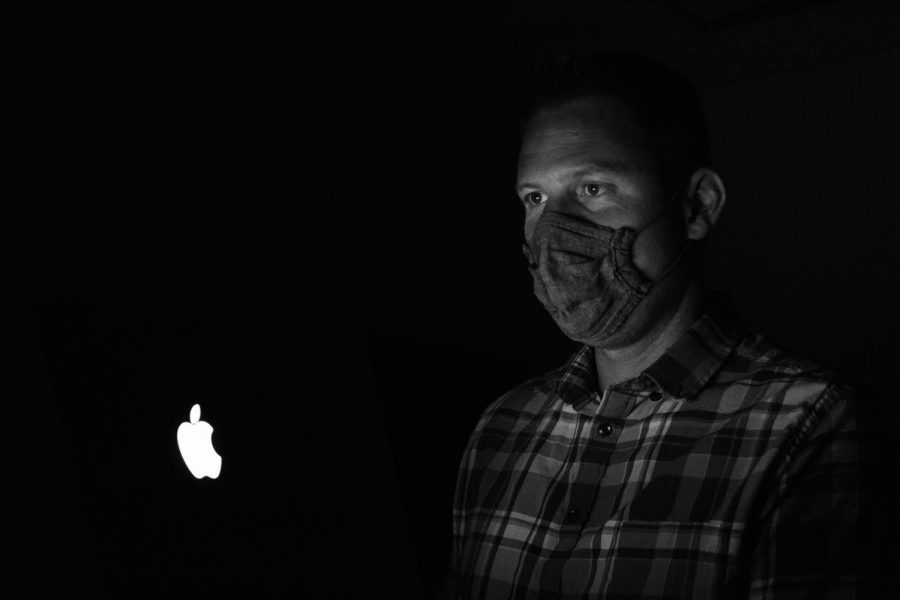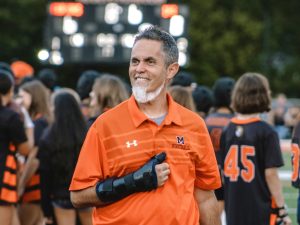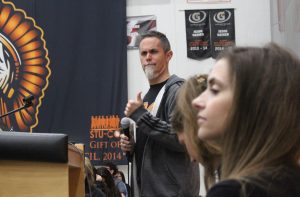The teacher becomes the student
MCHS teachers learn and grow alongside students during both hybrid and remote learning
Throughout the pandemic, teachers have had to shift their practices many times between asynchronous remote learning, synchronous remote learning, and various hybrid learning models. This has been difficult for them as well as their students, but all of them have persevered and grown.
April 30, 2021
A classroom is filled with chatter as the students within it settle into their seats. The bell rings, and a teacher scrambles to get the classroom under control. They begin class, narrating a slideshow being broadcast onto the wall while their students take important notes. Halfway through, the teacher gasps, and dread fills their body; they haven’t started the Zoom for remote students.
As of the start of in-person learning, MCHS has changed the way school is being conducted this year three times already. For teachers who are being forced to adjust to these drastic changes quickly and efficiently or risk losing their jobs during both a pandemic and a national economic downturn in America, this has understandably been a great source of stress.
“I do think we’ve had a schedule whiplash a few times. Most of us are willing to make it work no matter what the plan is, but each new change is difficult for teachers—and students, which also adds difficulty for teachers and parents—and I wish maybe we could be a little more stable,” says English teacher Dane Erbach.
This “schedule whiplash” has been difficult for teachers in the context that as soon as they relearn how to go about teaching, they’re already moving onto a new way of teaching. Teacher’s confidence in their own abilities has understandably stumbled as a result.
“I think I’m doing a horrible job of teaching during hybrid! In some sense, I feel like I was just thrown on a desert island and told to just figure it out,” says science teacher Ryan Ellison.
Math teacher Kristian Hokinson feels similarly. “In the past, I would always have a bucket of candy in my class for [students] to snack on and water bottles for them. My wife would frequently bake chocolate chip cookies as a bribe to get [students] to do their Khan Academy. I thought to myself, ‘How could I do any of that if the kids aren’t in school?’ So, I was more than worried. I was honestly freaking out about how I would be able to get students to do anything, and I had no idea how I was going to create strong positive connections with them over a computer screen,” he says.
This sense of unpreparedness is not a case-by-case situation; the transition to hybrid learning has been a rocky one for all teachers, whether it’s because of technology, student participation, an increased workload on teachers, or simply because of the general stress that has come upon everyone as a result of the pandemic.
“There was definitely a transition period when we switched to hybrid. I would describe it as a ‘rough landing,’” says English and English Learner teacher Lauren PennyMartin.
For English teacher Ashley Diedrich, this “rough landing” was characterized by a variety of new worries. “We worried about connecting with our students and providing the assistance they needed,” she says.
However, student participation and teacher’s workload have always been an issue within schools; the concern for student’s and teacher’s own health, however, has not. “My worries prior to the beginning of the school year were my students and their families. Many students had shared that someone in their family or household had COVID and that they were concerned for their well-being. These concerns [have not] shifted or swayed for me.” says English Learner and Spanish teacher Otto Corzo.
For Erbach, student and teacher adherence to safety protocol, and the confrontations that have resulted because of it, has been one of his biggest stressors. “I was really worried about hybrid. I was finding myself getting irrationally angry when I saw students and teachers not wearing their masks properly. I had to call a teacher out one day, and it was the worst feeling ever.”
On the other hand, the stress that has come from teachers having to work closely with technology and learn how to effectively use new programs has also proven to be a major curve ball. “I have always struggled with using tech, which could get in the way of conveying my knowledge of mathematics,” says math teacher Robert Johnson.
Business teacher Tim Kirk also describes how technology has been a buffer between his knowledge and his student’s education. “We’re juggling many things; screens, iPads, remotes, Schoology assignments, etc. I’ve had students just sit there for half a class saying nothing before I figured out I wasn’t sharing [my screen].”
The challenges teachers are facing have proven to be tough, and a once in a lifetime experience. As a result, teachers have had to be creative, brave, and resilient when figuring out how to overcome them. “I am trying to make all of my materials digital for all students to have equal access to content and what we cover in class. I have learned many new technologies and reformatted previously created materials to work better in a digital or hybrid format to help support all my students,” says Jordan Deener.
As for Corzo, he has gotten his ideas for teaching during this time from several resources, including all over the internet. “I was close to adopting a Bitmoji classroom like many teachers on social media and at MCHS. I get many ideas from Twitter and Instagram,” he says.
Despite teacher’s best efforts, teachers still would like students to realize that in order for everyone to succeed, both sides need to be doing their fair share.
“Now that we’re part in person and part on Zoom, the ‘Zoomers’ need to do their part to be included in class. Show your face, ask questions, shout an ‘Amen!’ or a ‘Tell it like it is!’ when I’m preaching and teaching,” Kirk laughs. “Making timely comments or clarifying questions would be huge for classroom engagement.”
Despite the challenges presented, the unique situation students and teachers have found themselves in has proven to be a source of joy too. “I have really enjoy getting to know my students in this unique format. It’s also so fun when students’ pets or siblings pop onto the screen. It offers insight that we wouldn’t otherwise be afforded,” says PennyMartin.
In addition to this, teachers hope that students can remember that they too are in need of support, understanding, and a friendly face now more than ever.
“Please remember that teachers are people too. The emotions that you are experiencing throughout this ordeal, your teachers are probably experiencing similar, if not the same, feelings and emotions,” says Hokinson.
PennyMartin agrees with this notion, saying, “We need to be more patient and gracious with each other than ever before.”
Still, teachers are here to help all students no matter what is going on in their lives. After all, that’s why they do what they do. “No matter how stressed their teachers may seem at times, we are always here to help you. I wouldn’t be a teacher if I didn’t truly enjoy working with and helping students achieve their best. Students are not alone throughout this thing,” says Hokinson.
Note: Dane Erbach, featured in this story, advises the McHenry Messenger.












